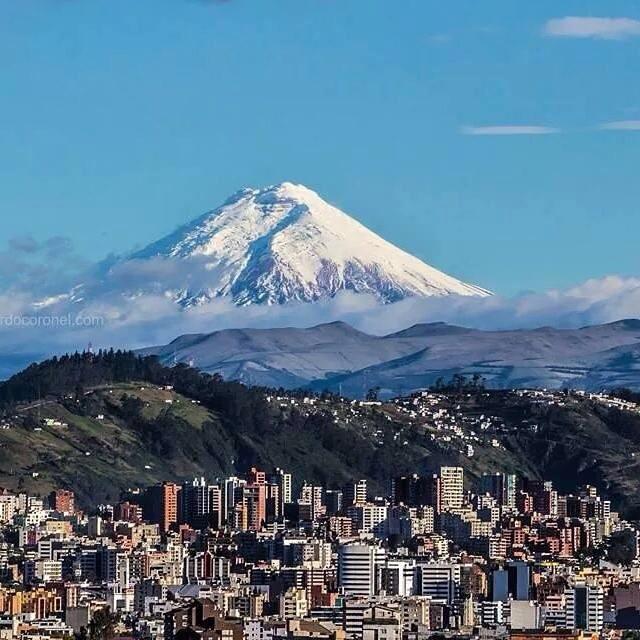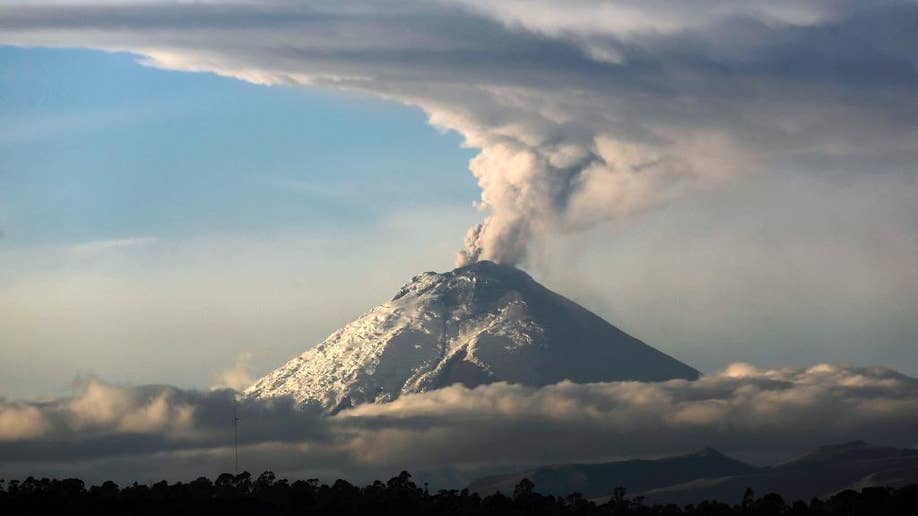Tuesday,
February 12, 2019
The nice thing about this apartment is that it backs onto a pedestrian walkway, so there is very little traffic noise. The pedestrian walkway, however, is quite well lit at night. The blinds in the bedroom did absolutely nothing to keep the light out. Thank goodness we packed sleep masks!
Today we took a private tour (just us) to Cotopaxi National Park. We met our driver Christian at the Hotel Quito at 8 am, which was an 8 minute walk away. We figured that would be easier than him trying to find the apartment.
On the way, we stopped at an overlook of Quito. Quito is 20 kms wide and 60 km north to south.
Cotopaxi National Park is 60 km south of Quito and took us about 2 hours to get there. You can see Cotopaxi quite clearly from Quito on a clear day:

Today we took a private tour (just us) to Cotopaxi National Park. We met our driver Christian at the Hotel Quito at 8 am, which was an 8 minute walk away. We figured that would be easier than him trying to find the apartment.
On the way, we stopped at an overlook of Quito. Quito is 20 kms wide and 60 km north to south.
Cotopaxi National Park is 60 km south of Quito and took us about 2 hours to get there. You can see Cotopaxi quite clearly from Quito on a clear day:

imagecredit:https://cairesonmission.com/2015/09/16/are-you-ready/
It
was declared a national park in 1975, and has almost 80,000 acres.
It is best known for the Cotopaxi Volcano, which is Ecuador's 2nd
highest peak at 19,347 ft (5,897 m). It is the world's highest
continuously active volcano. There have been 87 recorded eruptions.
The nearby city of Latacunga (population 100,000) has been completely
destroyed twice.


imagecredit:https://www.foxnews.com/world/new-bursts-of-ash-and-gas-rise-from-ecuadors-cotopaxi-volcano
The
worst eruption occurred in 1877. The volcano violently ejected hot
ash, lava fragments, and gases that flowed at great speed, reaching
Quito within 3 hours and covering the city in 6 mm of ash.

imagecredit:https://cuencahighlife.com/explosions-and-earthquakes-rock-cotopaxi-volcano-ashfall-and-the-smell-of-sulfur-reported-in-southern-suburbs-of-quito/
The
most recent eruption was in August, 2015. There were 2 eruptions
followed by 2,100 minor earthquakes and 20,000 tonnes of sulfur
dioxide emissions. Following this eruption, the national park was
closed to visitors but has recently reopened. The park has reopened
the trail to the Jose Ribas Refuge at 15,748 ft (4,800 m).


imagecredit:https://photoseek.photoshelter.com/image/I0000eO7aPAqxWf8
The
Ecuadorian Ministry of Tourism assures visitors that they have
everything firmly under control. From their website:
The
Ecuadorian Government have improved the volcanic monitoring system.
Evidence of this is the provision of technological equipment that
reinforces the current monitoring network, which operates 365 days a
year and supports the Early Warning System. Among them: 16 seismic
stations, 5 infrasound detectors, 13 lahars detectors, 7 video
telemetry stations, 1 thermal imaging camera, 12 deformation control
lines, 5 inclinometers, 5 GPS stations, 5 gas monitoring stations, 1
multi-gas mobile, Ash meters and 10 repeaters.
Since
the volcano is so high, there is actually a glacier at the top.
Ecuadorians love to climb the volcano, and for many of them, it is
their first exposure to snow.
The terrain of the national park is relatively flat with large volcanic boulders, until the volcano surges up out of it. This makes it easy to see the volcano no matter where you are. The land below the volcano is an ecological reserve. Wildlife includes wolves, pumas, bears, condors, wild horses, and foxes.
The terrain of the national park is relatively flat with large volcanic boulders, until the volcano surges up out of it. This makes it easy to see the volcano no matter where you are. The land below the volcano is an ecological reserve. Wildlife includes wolves, pumas, bears, condors, wild horses, and foxes.
We were a little surprised when Christian said we were leaving his car at the visitor center, and taking a park vehicle, along with another guide and driver. So now there were 5 of us. Christian said the road in was too rough and he wanted to save his car. They called the ride a "free massage".
The
visit began with the Visitor Center and small museum. The museum and
surrounding hiking trails are at an elevation of 14,764 ft (4,500 m),
almost as high as the refuge. The museum just opened yesterday, so the guides were tickled pink to go through, and took a really long time explaining everything you wanted to know about the park (and everything you didn't want to know!).
From the museum, we hiked 1½ km on a trail through what they called a "botanical garden". We only saw a few flowers, it just looked like a nice trail to us. We wondered why they kept stopping at every little plant and flower to show us. Then the altitude started to get to us and we were huffing and puffing, so taking pictures of every little plant and flower became a great excuse to rest.
We followed along a ravine:
We followed along a ravine:
It took us twice as long to hike this trail as it would have back home. It kept seeming to go up and up.
There
are several small lakes in the park, and one larger lake, Laguna
Limpiopungo. This is a seasonal lake which grows larger in size
during the rainy season.
We took a 2½ km hike around the lake, going very slowly! Our new guide Marina had an eagle eye for finding every little plant or animal. We could not believe there are lizards living here, it was a chilly 10C up here.
And breezy, as you can tell by these pictures:
There were several times when we were able to see Cotapaxi without clouds. The vertical cloud wall was very interesting.
This area is where wild horses and llamas are often seen grazing.
By the time we were done this second hike, they asked if we wanted to go hike a different area. But it was 1:30 and we were very hungry, so we all headed back. We said goodbye to the extra driver, and Marina:
Christian wouldn't let us eat at the visitor center restaurant, he said they wouldn't be able to accommodate any "eating restrictions". He promised to take us to a nice restaurant "only 20 minutes away". Hmph. He took us onto some back roads that led where? To a guarded colonial mansion.
Anton asked how much lunch would cost here. Only $25US each. 1) We didn't bring that kind of money for lunch; and 2) Can you say driver kickback???? So we said no and he said he could take us to another town for lunch, only half an hour away. By this time it was close to 3pm, so we told him to take us back to our bnb. Can you say "hangry"?
So we had a rather early supper (late lunch?) of kraft dinner and felt much better.















No comments:
Post a Comment